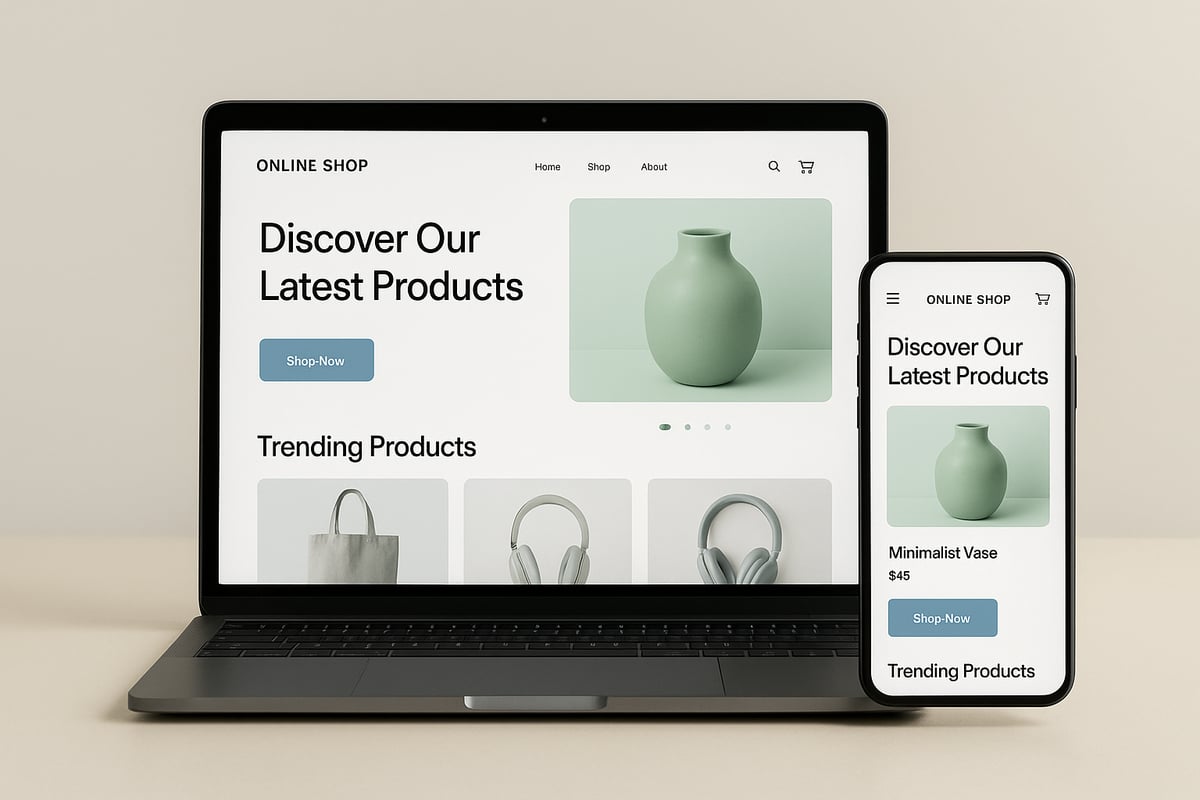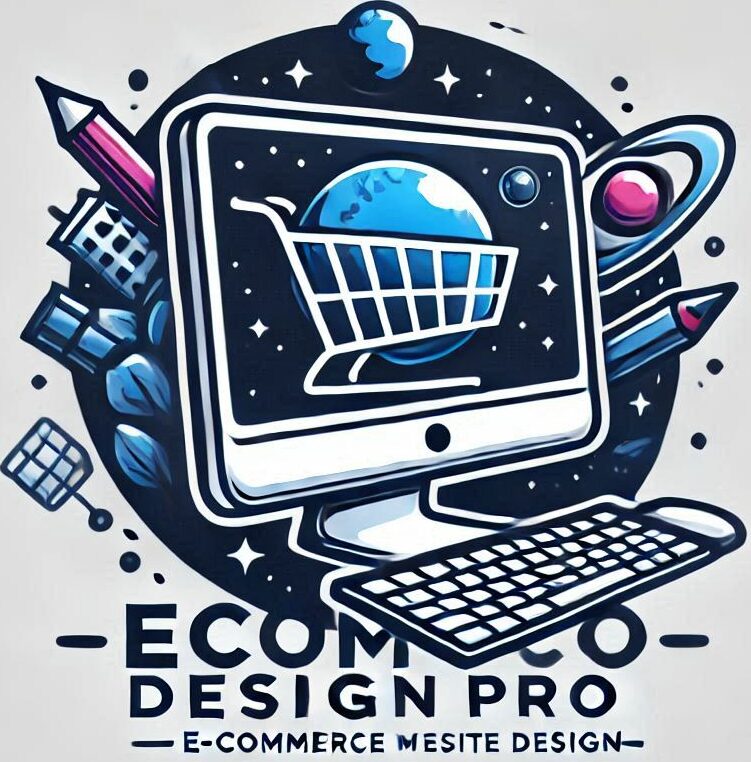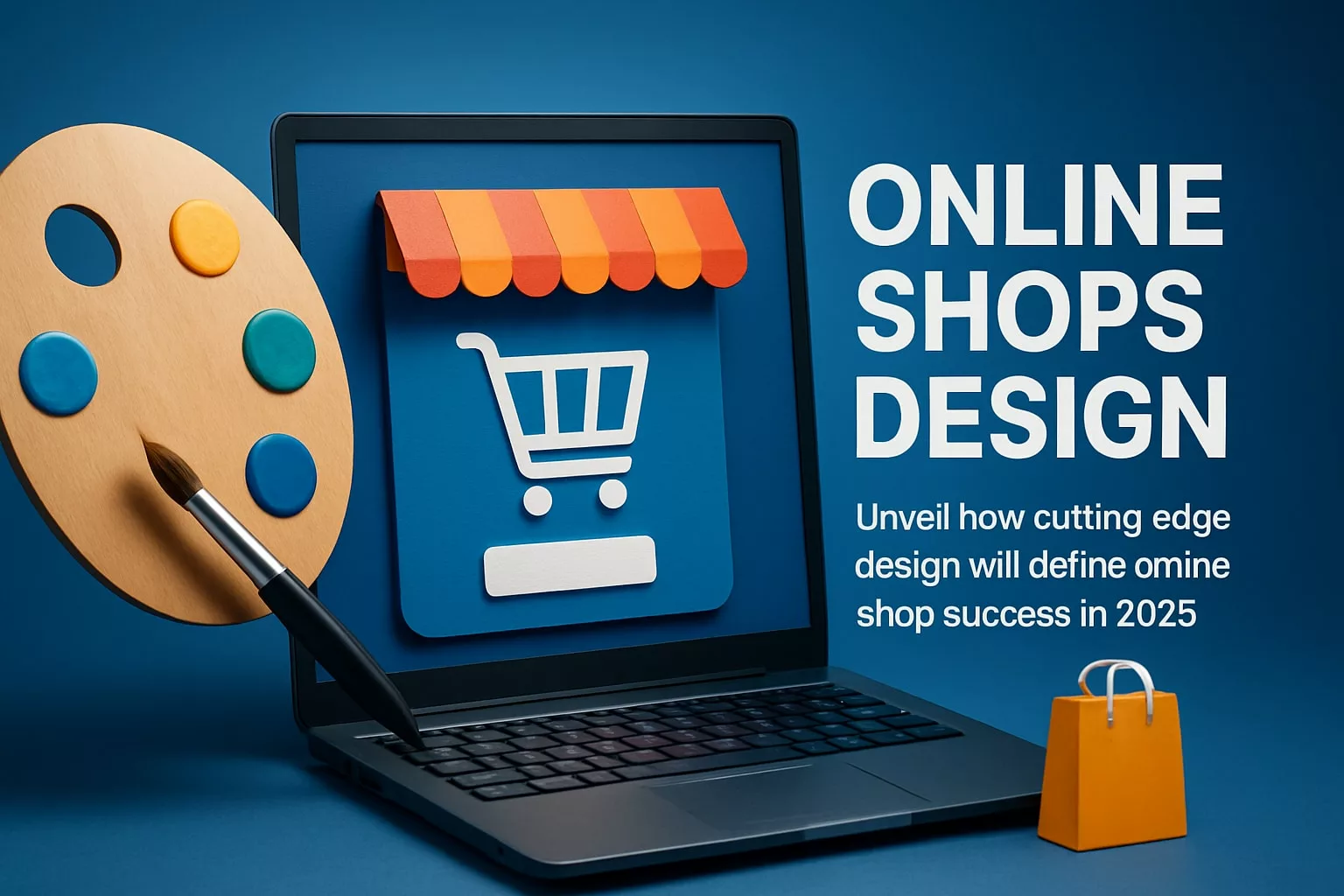How will online shops design define success in 2025? As technology and consumer expectations evolve rapidly, many e-commerce businesses find it tough to keep up. Staying ahead means more than just updating a website—it requires a strategic approach.
This guide provides expert insights and practical strategies to help you master online shops design for the future. You will discover the latest trends, user experience essentials, and the power of AI integration.
Explore solutions for accessibility, sustainability, and technical optimization. Get ready to future-proof your digital storefront, boost sales, and take action with proven steps from industry leaders.
The 2025 E-Commerce Design Landscape: Trends & Predictions
The world of online shops design is on the brink of transformation in 2025. As digital commerce evolves, businesses must adapt quickly to stay ahead. Industry leaders are already embracing new technologies and user-centric approaches, setting the stage for the next wave of innovation. For a comprehensive look at what's ahead, you can explore E-commerce Design Trends 2025, which highlights the most influential shifts shaping the industry.

Rise of AI-Driven Personalization
AI is rapidly redefining online shops design by delivering tailored shopping experiences. Advanced algorithms analyze user behavior in real time, enabling instant product recommendations that feel uniquely relevant. Retailers are increasingly deploying AI-powered chatbots to provide immediate support, answer questions, and guide customers through their buying journey.
The impact is clear: 74% of consumers now expect personalized interactions when shopping online. This shift not only builds loyalty but also drives higher conversion rates. As AI continues to evolve, online shops design will prioritize adaptive interfaces and intelligent content, making every visit feel custom-built for the individual.
Mobile-First & Responsive Design
With mobile commerce projected to account for 72% of all e-commerce sales by 2025, online shops design must embrace a mobile-first mindset. Shoppers move fluidly between devices, and seamless cross-device experiences are no longer optional. Responsive layouts adjust content for any screen size, while touch-friendly interfaces ensure smooth navigation.
Brands investing in mobile-optimized checkouts report up to 30% higher conversion rates. Features like sticky navigation and larger tap targets enhance usability, reducing friction at critical moments. In 2025, success will depend on an online shops design that feels intuitive and effortless on any device.
Voice & Visual Search Integration
Voice assistants and visual search tools are changing the way consumers interact with online shops design. Optimizing product listings for voice queries and image recognition technology is essential as more users speak or snap their way to products.
Retailers are leveraging tools like Google Lens to streamline product discovery, making it easier for shoppers to find what they want quickly. By anticipating these search trends, online shops design becomes more accessible and responsive to evolving customer behaviors, setting the stage for higher engagement and satisfaction.
Immersive Shopping: AR & VR Experiences
Augmented reality and virtual reality are transforming online shops design into interactive, immersive experiences. Virtual try-ons and 3D product views boost buyer confidence and significantly reduce returns. Retail adoption of AR is projected to grow by 35% annually through 2025, reflecting the demand for richer, more informative shopping journeys.
Shoppers can visualize furniture in their homes or test cosmetics virtually before buying. This hands-on approach elevates online shops design, turning browsing into an engaging, memorable experience that drives both sales and customer loyalty.
Sustainability & Ethical Design
Modern consumers expect online shops design to reflect their values, especially around sustainability and ethics. Demand is rising for eco-friendly materials, transparent supply chains, and carbon-neutral practices. Brands now highlight sustainability initiatives directly in their site design and messaging, reinforcing trust and authenticity.
Green design elements, such as energy-efficient hosting and minimal packaging, are becoming standard. By prioritizing ethical considerations, online shops design not only meets regulatory expectations but also appeals to a growing segment of conscious shoppers who seek brands with purpose.
User Experience (UX) Foundations for Online Shops
Delivering exceptional user experience is essential for the success of any online shops design. As digital storefronts evolve, customers expect seamless, intuitive, and secure journeys from the first click to checkout. Mastering these UX foundations will help your online shop stand out and convert more visitors.

Streamlined Navigation & Intuitive Layouts
Clear, logical navigation is the backbone of successful online shops design. Users should be able to find products quickly, without confusion. Implementing well-structured menus, logical product categories, and predictive search helps guide customers efficiently.
- Use sticky navigation bars for constant access to key pages
- Employ mega menus for organized, quick browsing
- Highlight featured or trending products for discovery
Leading retailers leverage these strategies to reduce friction and keep visitors engaged. For a comprehensive overview of these principles, refer to E-Commerce Design Best Practices.
Fast Load Times & Performance Optimization
Page speed is a critical factor in online shops design, directly impacting conversion rates. A one-second delay can result in a 7% drop in conversions, emphasizing the need for swift performance.
Optimize images by compressing files and using modern formats. Implement lazy loading to delay offscreen content, and utilize a content delivery network (CDN) for faster global access.
Google’s Core Web Vitals serve as benchmarks for measuring site performance, helping you prioritize improvements that matter most to users and search engines alike.
Accessible & Inclusive Design
Accessibility is a cornerstone of modern online shops design. Ensuring your site meets WCAG 2.2 and ADA guidelines opens your store to a wider audience, including those with disabilities.
- Maintain high color contrast for readability
- Enable keyboard navigation for ease of use
- Support screen readers with descriptive alt text
Retailers adopting accessible practices not only expand their reach but also demonstrate social responsibility. Prioritizing inclusion strengthens your brand reputation and customer loyalty.
Trust Signals & Secure Checkout
Building trust is crucial in online shops design, especially when handling sensitive customer information. Display SSL certificates, recognizable payment badges, and authentic customer reviews prominently throughout your site.
- Provide clear return and refund policies
- Make contact information easily accessible
- Show real-time stock and shipping updates
With 69% of shoppers abandoning carts due to security concerns, visible trust signals and transparent policies can significantly boost conversion and customer confidence.
Seamless Mobile Experience
A mobile-optimized online shops design is non-negotiable in 2025. Focus on thumb-friendly navigation, one-click checkout, and support for mobile wallets to streamline the purchase process.
- Use collapsible filters and sticky action buttons
- Design mobile-first product galleries for easy browsing
- Test all interactive elements for responsiveness
Brands implementing these mobile UX best practices consistently see higher average order values and improved customer retention.
Visual Design & Branding Strategies for 2025
A compelling visual identity will set online shops design apart in 2025. As digital competition intensifies, strategic branding and modern design principles become essential for attracting and retaining customers. Let us explore the four pillars shaping future-ready online shops design: minimalism, dynamic content, brand consistency, and micro-interactions.

Minimalism with Purpose
Minimalism remains a dominant force in online shops design, providing clarity and focus for shoppers. Clean layouts, generous whitespace, and carefully chosen visuals help reduce cognitive overload, making it easier for visitors to absorb information and make purchasing decisions.
Brands embracing minimalist online shops design report up to 20% higher engagement. By stripping away unnecessary elements, sites place products front and center, guiding users intuitively. Consider using simple navigation, unobtrusive menus, and a restrained color palette to highlight your brand’s personality while maintaining usability.
Minimalism not only looks modern but also supports accessibility and faster load times. The right balance ensures online shops design feels inviting, not empty.
Dynamic Imagery & Video Content
Dynamic visuals are vital for online shops design in 2025. High-resolution product photography, 360-degree views, and interactive videos allow shoppers to explore products in detail, building trust from the first click.
Short-form video demos and user-generated content add authenticity, influencing buyer confidence. Data shows that including video on product pages can boost conversions by up to 80%, making it a powerful tool for online shops design.
To maximize impact, integrate rich media seamlessly into your layout. Ensure images and videos are optimized for speed and mobile viewing, supporting a visually engaging and technically sound online shops design.
Consistent Brand Identity
Consistency is the backbone of strong online shops design. Cohesive color schemes, typography, and iconography reinforce your brand’s story at every touchpoint, driving recognition and trust.
Leading brands achieve this by establishing visual guidelines that extend across web, social, and email channels. Storytelling through design creates emotional connections, turning casual visitors into loyal customers. For online shops design, maintaining consistency ensures users always know where they are and what to expect.
A unified visual presence not only builds credibility but also simplifies navigation, making shopping intuitive and memorable.
Micro-Interactions & Animation
Micro-interactions breathe life into online shops design, offering subtle cues that delight users and guide their actions. Hover effects, button animations, and loading indicators provide feedback, making the experience feel intuitive and polished.
Data reveals that micro-interactions can improve perceived usability and retention. In online shops design, these small touches reassure shoppers, clarify next steps, and create an engaging environment.
Consider incorporating micro-animations for add-to-cart actions, wishlists, or product quick views. When executed thoughtfully, micro-interactions enhance both the look and the feel of your online shops design, setting your brand apart in a competitive market.
Integrating Advanced Technologies for Competitive Advantage
Staying ahead in online shops design requires integrating advanced technologies that not only improve customer experience but also streamline operations. E-commerce leaders in 2025 are leveraging innovation to gain a measurable edge in a highly competitive market.

AI-Powered Product Recommendations
Artificial intelligence is transforming online shops design by enabling highly personalized shopping journeys. Machine learning algorithms analyze browsing and purchase history to deliver relevant product suggestions in real time. Retailers use these tools to cross-sell and upsell products, increasing average order value and customer satisfaction.
For example, AI-driven recommendation engines can highlight complementary accessories as a shopper adds items to their cart. This level of personalization is now expected by consumers, making it a necessity in modern online shops design. For a deeper look at how these systems are revolutionizing e-commerce, explore AI-Powered Personalization in E-Commerce.
Businesses that invest in these solutions see improved conversion rates and stronger customer loyalty.
Chatbots & Conversational Commerce
Chatbots are now essential components of online shops design, providing instant support and personalized product guidance around the clock. By using natural language processing, these intelligent assistants answer questions, recommend products, and resolve issues efficiently.
Shoppers can engage with chatbots to find the right size, check order status, or get tailored suggestions. This reduces friction in the buying process and builds trust with customers. As conversational commerce grows, online shops design must prioritize seamless chatbot integration to meet evolving shopper expectations.
The result is a more interactive and supportive experience that drives repeat business.
Augmented Reality (AR) Product Visualization
Augmented reality is redefining online shops design by allowing customers to virtually try on products or visualize items in their own space. From apparel to furniture and cosmetics, AR tools help shoppers make confident decisions without visiting a physical store.
Brands adopting AR in online shops design report fewer returns and higher conversion rates. Features like 3D product views and interactive previews give customers a realistic sense of size, color, and fit. This immersive approach not only enhances satisfaction but also differentiates leading retailers from competitors.
Embracing AR is a forward-thinking step for any e-commerce business.
Automation & Smart Inventory Management
Automation is streamlining the operational side of online shops design, making processes more efficient and less prone to error. Smart systems handle tasks like restocking, dynamic pricing, and predictive analytics, freeing up staff to focus on growth strategies.
For example, automated inventory management can alert teams about low stock or trigger reordering, ensuring popular products are always available. Dynamic pricing tools adjust prices based on demand and competition, maximizing revenue.
Integrating these technologies into online shops design reduces costs, improves accuracy, and supports a seamless customer experience.
Step-by-Step Guide: Designing a High-Converting Online Shop in 2025
Creating a high-converting online shop in 2025 requires a structured approach, blending innovation, data, and user-focused strategies. This guide breaks down the online shops design process into seven actionable steps, empowering you to build a digital storefront that delights customers and drives results.
Step 1: Research & Define Your Target Audience
Effective online shops design begins with understanding who your customers are. Identify core personas by analyzing demographics, interests, and shopping behaviors.
Use analytics platforms and market research tools to uncover patterns such as device preferences, purchase intent, and browsing habits. Segment your audience by age groups, geographic regions, and typical spending levels.
- Build detailed personas for primary and secondary audiences.
- Examine competitors’ customer bases for gaps and opportunities.
- Continuously update insights as trends shift.
By grounding your online shops design in real data, you ensure every decision supports your business goals and resonates with your ideal shoppers.
Step 2: Plan User Journeys & Site Architecture
Mapping clear user journeys is essential for successful online shops design. Visualize the steps customers take from first visit to completed purchase.
Prioritize essential pages like home, product listings, and checkout. Use wireframes and flowcharts to lay out site structure, ensuring logical navigation and minimal friction.
- Highlight key conversion points along the path.
- Identify potential bottlenecks or distractions.
- Create a sitemap that reflects your product hierarchy.
A well-planned architecture keeps visitors engaged and helps them move seamlessly toward conversion, forming the backbone of effective online shops design.
Step 3: Choose the Right E-Commerce Platform & Tools
Selecting the right technology stack is a cornerstone of online shops design. Assess your business needs for scalability, customization, and integration with third-party tools.
Compare leading platforms such as Shopify, WooCommerce, and Magento in terms of features, support, and cost. For greater flexibility, consider headless commerce solutions that decouple the front end from the back end.
| Platform | Scalability | Customization | Integrations |
|---|---|---|---|
| Shopify | High | Moderate | Extensive |
| WooCommerce | Moderate | High | Wide |
| Magento | Very High | Advanced | Robust |
Making informed platform choices ensures your online shops design can adapt as your business grows and technology evolves.
Step 4: Design for Mobile-First & Accessibility
In 2025, mobile shoppers dominate the market, making mobile-first online shops design a necessity. Implement responsive layouts and touch-friendly elements for seamless browsing on any device.
Accessibility is equally critical. Follow WCAG 2.2 standards, ensuring color contrast, keyboard navigation, and screen reader compatibility. Test your shop across devices and assistive technologies to guarantee inclusivity.
For actionable strategies, explore Mobile-First E-Commerce Design Tips to optimize your approach.
By prioritizing both mobile usability and accessibility, your online shops design welcomes a broader audience and maximizes engagement.
Step 5: Optimize Visuals & Content
Compelling visuals and clear content are pillars of high-performing online shops design. Use high-resolution images and short videos to showcase products from multiple angles.
Write concise, benefit-driven product descriptions. Implement SEO best practices, including keyword-rich titles and alt text, to boost visibility. Encourage user-generated content like reviews and photos for authenticity.
- Ensure fast-loading images with proper compression.
- Use consistent branding in all visual assets.
- Structure information with bullet points for easy scanning.
A strategic focus on visuals and content elevates your online shops design, building trust and driving conversions.
Step 6: Integrate AI & Automation Features
Modern online shops design thrives on intelligent automation. Incorporate AI-powered recommendation engines and chatbots to personalize the shopping experience.
Enable dynamic pricing and smart inventory management to optimize sales and stock levels. Automate follow-up emails for abandoned carts, increasing recovery rates. For recent trends in AI-driven sales, see AI’s Impact on Online Sales.
By leveraging automation, your online shops design becomes more efficient, adaptive, and customer-centric.
Step 7: Test, Analyze & Iterate
Continuous improvement is fundamental to successful online shops design. Conduct usability tests to gather feedback on navigation, content clarity, and checkout flow.
Monitor analytics for metrics like conversion rates, bounce rates, and session duration. Identify friction points and optimize based on data.
- Set up A/B tests for key pages and CTAs.
- Use heatmaps and user recordings to spot issues.
- Establish a regular review cycle for ongoing enhancements.
Iterative refinement ensures your online shops design remains competitive and aligned with evolving user expectations.
Measuring Success: Key Metrics & Optimization Tactics
To ensure your online shops design delivers results in 2025, tracking the right metrics is essential. Success goes beyond aesthetics; it is measured by how effectively your site converts visitors, retains customers, and drives sustainable growth. By focusing on data-driven optimization tactics, you can transform your store into a high-performing digital destination.
Conversion Rate Optimization (CRO)
Conversion Rate Optimization is the foundation of online shops design success. Small changes, such as A/B testing call-to-action buttons or streamlining checkout flows, can yield significant improvements. For example, even altering button colors or microcopy can increase conversions by 15%.
Identify friction points using analytics and heatmaps. Reduce cart abandonment by simplifying forms and offering guest checkout options. CRO is not a one-time task; it requires ongoing experimentation. Leveraging data from AI in E-commerce Statistics can reveal which AI-powered personalization tactics drive higher conversion rates, supporting continuous growth in your online shops design.
User Engagement & Retention Metrics
Monitoring user engagement is vital for long-term success. Key metrics include bounce rate, session duration, and repeat visit frequency. Engaged visitors are four times more likely to convert, making retention strategies a priority for any online shops design.
Implement loyalty programs, personalized follow-ups, and relevant product recommendations to encourage repeat purchases. Use segmentation to tailor offers and content. Remember, a well-designed experience keeps users returning, and measuring these metrics helps refine your online shops design for even better results.
SEO & Organic Traffic Growth
Organic visibility is a core driver of sustainable growth for online shops design. Optimize metadata, product descriptions, and structured data to improve search rankings. Implement schema markup, which can increase click-through rates by making your listings more appealing in search results.
Track keyword performance and organic traffic sources regularly. Internal linking and clear site architecture also play a role in boosting SEO. By focusing on these elements, you ensure your online shops design attracts quality traffic and maximizes discoverability.
Performance Monitoring & Continuous Improvement
The most successful online shops design strategies rely on continuous monitoring and iteration. Use tools like Google Analytics and Hotjar to gather actionable insights into user behavior. Set clear KPIs, and benchmark your performance against industry standards.
Establish a feedback loop by collecting customer input and analyzing conversion data. Adapting your design based on real-world results ensures your online shops design remains competitive. For accessibility improvements, consult resources like the Guidelines for Ensuring E-Commerce Accessibility to make your site usable for all customers.



